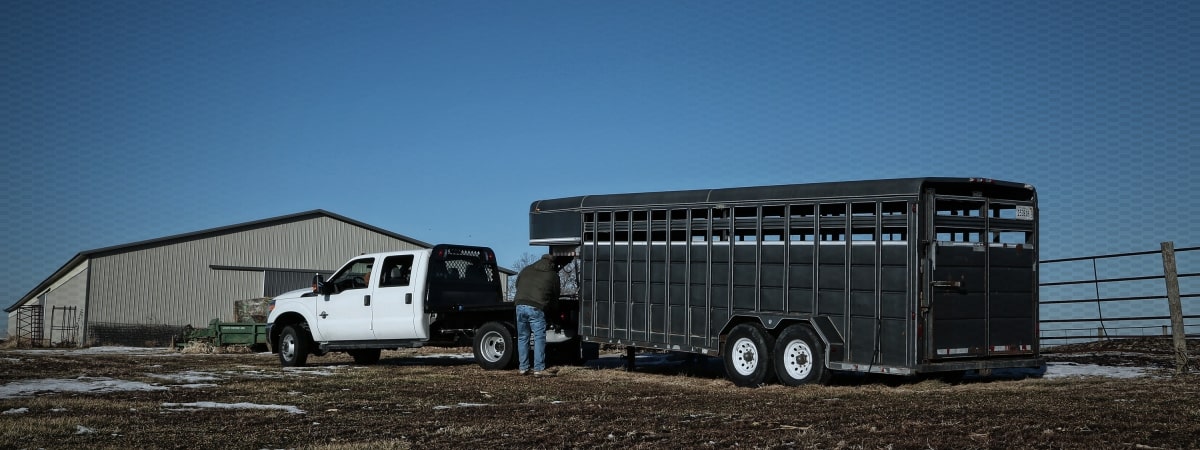September 1, 2016
SHARE
Gooseneck trailers are commonly utilized in many different applications, from hauling livestock to heavy equipment. Unlike receiver hitch trailers, gooseneck trailers are towed via a gooseneck hitch system, located directly over the rear axle which distributes the weight of the load more evenly and allows for heavier loads. The gooseneck hitch system ties directly into the frame rails, making it robust and strong. Gooseneck trailers allow for a tighter turning radius and are generally easier to line-up for connection.
Although gooseneck trailers are generally rated for much heavier loads in comparison to receiver hitch trailers, you should always ensure your total trailer weight (empty trailer weight plus the cargo weight) does not exceed the tow ratings of the truck or the gooseneck hitch system. Gooseneck hitch systems will have two ratings, a gross trailer weight and a tongue weight. Always comply with state towing regulations. Be aware that towing regulations vary from state to state, so understand your local state regulations and any other states you plan to travel through while towing a gooseneck trailer.
Pre-departure
- Check tire pressure on all tires on both the trailer and the truck to ensure they are within the manufacturer’s range.
- Your trailer will be compatible with a specific size of gooseneck hitch ball, usually 2 5/16” although sometimes heavy-duty trailers need a 3” gooseneck ball. Too big of a ball and the trailer won’t seat properly, too small of a ball means your coupler won’t securely lock down increasing the risk of your trailer popping off the ball. Make sure your trailer and gooseneck hitch system are compatible.
- The trailer should be seated all the way down on the gooseneck hitch ball to allow the coupler to lock down securely.
- Gooseneck hitch systems should have integrated safety chain attachment points, connect your trailer safety chains to the attachment points.
- Connect the trailer light harness into the integrated trailer plug and test all trailer lights including back-up, turn signal, tail lights and brake lights.
- Balance the load evenly on the trailer, side to side and front to back.
- If you are hauling heavy equipment or materials, secure the load with sufficiently rated chains or straps to reduce the risk of your cargo shifting during transport.
- Your side mirrors should extend wide enough to view the trailer tires without having to adjust your position in the drivers seat.
On The Road
- Gradual accelerating and decelerating is less taxing on both your truck and your trailer and also minimizes the risk of shifting and damaging your cargo. Hard stops and quick take-offs should be avoided.
- Slow down, many states have a slower highway speed limit when hauling a trailer. As the operator, you need to stay at or below the legal speed limit to keep you and the vehicles around you safe.
- Most new trucks have an electric brake controller that can be adjusted from the cab. Each time you haul, make the proper adjustments to the electric brake controller for a smoother haul.
- Allow for ample distance between you and the vehicle in front of you. The two second rule of thumb should be increased to four seconds at minimum. The heavier the load, the more time it will take to bring it to a complete stop.
- Swing out wide when turning. Receiver hitch trailers generally follow the same path as the tow vehicle while gooseneck trailers cut much closer on turns.
- If possible, down-shift your truck on a decline. This will help slow your speed and reduce the stress on the vehicle and trailer brake systems.
Always take the proper precautions before your haul and utilize safe towing techniques on the road to reduce the risk of an accident. If you lack experience with hauling a gooseneck trailer, find an open and empty parking lot to practice critical maneuvers such as turning, backing up and parking. Safety should always be top of mind regardless if you are hauling an empty or loaded gooseneck trailer.


